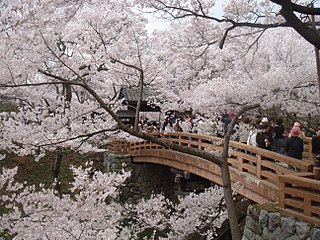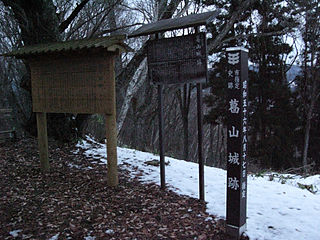
Takeda Shingen was daimyo of Kai Province during the Sengoku period of Japan. Known as "the Tiger of Kai", he was one of the most powerful daimyo of the late Sengoku period, and credited with exceptional military prestige. Shingen was based in a poor area with little arable land and no access to the sea, but he became one of Japan's leading daimyo. His skills are highly esteemed and on par with Mōri Motonari.

Murakami Yoshikiyo was a Japanese samurai from the Murakami clan and retainer of the Uesugi clan during the Sengoku period of the 16th century. Yoshikiyo followed in fighting against both Takeda Nobutora and his son Takeda Shingen. Yoshikiyo was also a very close ally under Uesugi Kenshin and one of Shingen's bitterest opponents for his high kill-counts in their conflicts.

Takeda Katsuyori was a Japanese daimyō of the Sengoku period, who was famed as the head of the Takeda clan and the successor to the legendary warlord Takeda Shingen. He was son-in-law of Hojo Ujiyasu, daimyō of Hojo clan.
Ogasawara Nagatoki (小笠原長時) was a Japanese samurai daimyō of Shinano Province in the Sengoku period.

Takeda Nobutora was a Japanese daimyō who controlled the Province of Kai, and fought in a number of battles of the Sengoku period. He was the father and predecessor of the famous Takeda Shingen.

Takeda Nobukado was a Japanese samurai (warrior) and general of the Takeda clan during the Sengoku period. He was known as one of the "Twenty-Four Generals of Takeda Shingen". He is also well known as a painter.

Takeda Nobushige was a samurai of Japan's Sengoku period, and younger brother of Takeda Shingen. He was known as one of the "Twenty-Four Generals of Takeda Shingen".

The Battle of Sezawa was the first major battle fought by Takeda Shingen in his campaign to gain control of Shinano Province. He took on and defeated a coalition of Shinano daimyō including the leaders of the Suwa, Ogasawara and Murakami clans.
The siege of Uehara was the first of many steps taken by Takeda Shingen in his bid to seize control of Shinano Province. Uehara Castle had been controlled by Suwa Yorishige before it was taken by Shingen.
The siege of Kuwabara took place the day after the siege of Uehara; Takeda Shingen continued to gain power in Shinano Province by seizing Kuwabara castle from Suwa Yorishige. Suwa was escorted back to the provincial capital of Kōfu under "the pretext of safe conduct, but he was then forced to commit suicide."
Suwa Yorishige (諏訪頼重) (1516–1544) was a Japanese samurai, daimyo of Shinano province and head of the Suwa clan. He was defeated by Takeda Shingen, and his daughter Suwa Goryōnin was taken as Shingen's concubine. She later gave birth to the Takeda clan heir Takeda Katsuyori.

Suwa Grand Shrine, historically also known as Suwa Shrine or Suwa Daimyōjin (諏訪大明神), is a group of Shinto shrines in Nagano Prefecture, Japan. The shrine complex is the ichinomiya of former Shinano Province and is considered to be one of the oldest shrines in existence, being implied by the Nihon Shoki to already stand in the late 7th century.
Anayama Nobutomo was a Japanese samurai and of the Sengoku period. He was the son of Anayama Nobutsuna. Nobutomo served the Takeda clan of Kai Province and held the title of Izu-no-kami (伊豆守), or Defender of Izu.

Samurai Banners is a Japanese samurai drama film released in 1969. It was directed by Hiroshi Inagaki and is based on the novel Furin kazan by Yasushi Inoue.

The Suwa clan, also known as the Jin or Miwa clan was a Japanese shake and samurai family. Originating from the area encompassing Lake Suwa in Shinano Province, it was originally a family of priests who served at the Upper Shrine of Suwa located on the southwestern side of the lake. By the Kamakura period, it thrived as a prominent samurai clan with close ties to the shogunate.

Suwa Domain was a feudal domain under the Tokugawa shogunate of Edo period Japan. It was located in Shinano Province, Honshū. The domain was centered at Takashima Castle, located in what is now part of the town of Suwa in Nagano Prefecture. It was also known as Takashima Domain.

Takatō Castle is a Japanese castle located in the city of Ina, southern Nagano Prefecture, Japan. At the end of the Edo period, Takatō Castle was home to a cadet branch of the Naitō clan, daimyō of Takatō Domain. The castle was also known as Kabuto Castle. Built sometime in the 16th century, it is now largely in ruins.

Takashima Castle is a Japanese castle located in Suwa, central Nagano Prefecture, Japan. At the end of the Edo period, Takashima Castle was home to the Suwa clan, daimyō of Takashima Domain. The castle is also known as ’The Floating Castle of Suwa’’’ or Shimazaki Castle

The siege of Katsurayama in March 1557 was fought between the forces of the Japanese daimyō Takeda Shingen and Uesugi Kenshin as part of the Kawanakajima campaigns. Katsurayama Castle was a strategically vital Uesugi stronghold in the contested Shinano Province and, when it was isolated from reinforcements due to late snow in early 1557, the Takeda clan used this opportunity to attack it. Although the castle garrison, consisting of the Ochiai clan and elements of the Murakami clan, defended Katsurayama furiously, the Takeda forces under Baba Nobuharu eventually stormed into the castle. Most of the garrison was killed in combat, while the families of the defenders committed mass suicide and the castle was burned to the ground.













